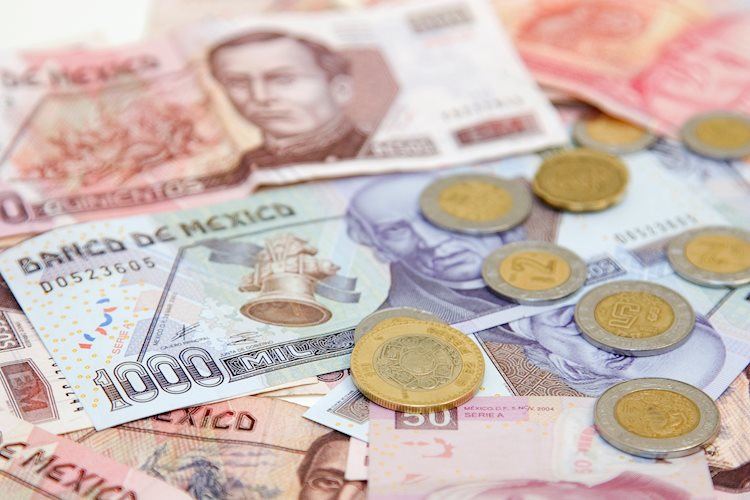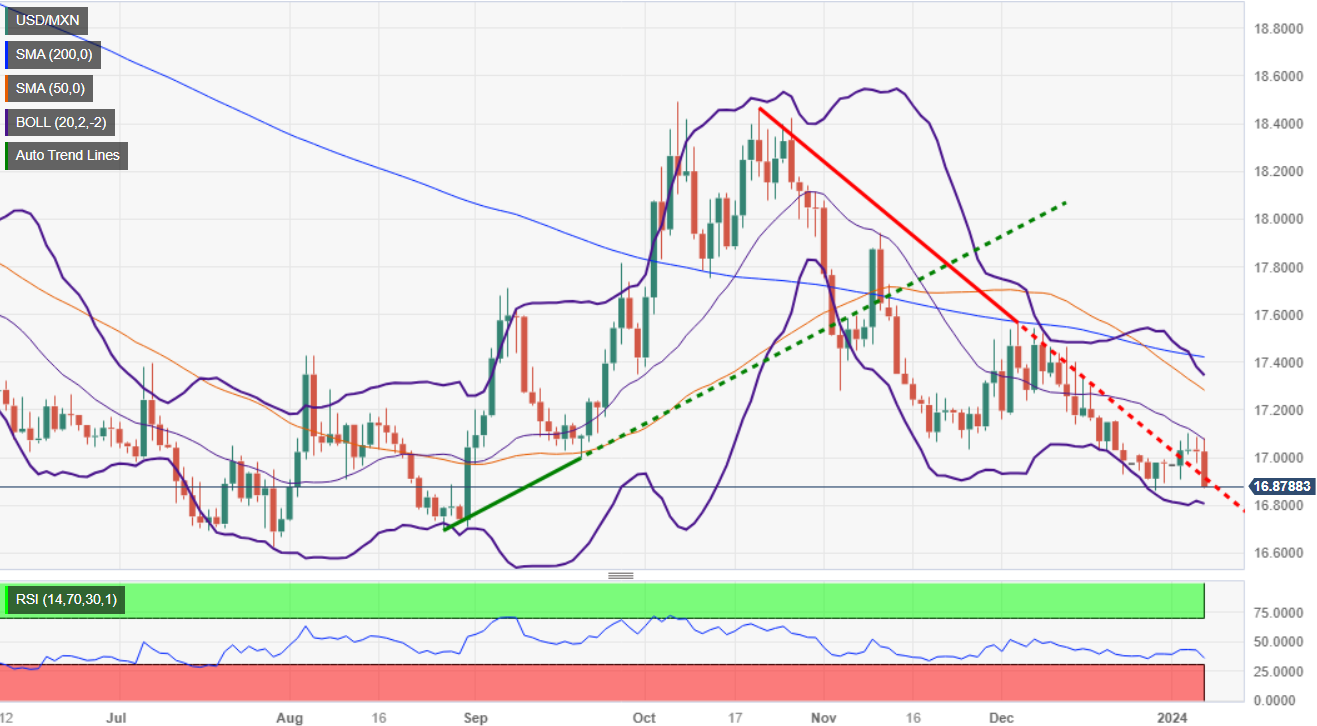- Mexican Peso gains against USD, with USD/MXN falling to 16.87 after US jobs data shows higher-than-expected employment growth.
- Banxico’s recent minutes highlight ongoing inflation challenges, affirming the need for stable interest rates.
- Economic data from the United States was mixed, though it maintains a Goldilocks scenario.
- US Treasury yields rise as market expectations for Fed rate cuts in 2024 adjust to 135 basis points.
The Mexican Peso (MXN) stages a comeback and registers a new three-day high against the US Dollar (USD) after the US Bureau of Labor Statistics (BLS) revealed the economy in the United States (US) added more jobs than expected in December. Recently, additional data from the Institute for Supply Management (ISM) suggests that business activity in the services sector is at recessionary levels, weighing on the Greenback. At the time of writing, the USD/MXN is trading at 16.87, down 0.83%.
Mexico’s economic docket is absent on Friday, but the release of the latest Bank of Mexico (Banxico) minutes on Thursday suggested the inflationary scenario in the country poses challenges, which is why it sees it necessary to maintain rates at current levels “for a certain time.”
Data from the United States (US) included jobs data, which surprisingly crushed estimates, while a survey of the ISM fell into recessionary territory. At the same time, Factory Orders of US-made goods exceeded October’s data.
Daily digest market movers: Mexican Peso remains firm, extending its gains against the US Dollar
- Factory Orders in December rose by 2.6% in November, exceeding October’s plunge.
- On Friday, the Institute for Supply Management (ISM) reported that the Non-Manufacturing PMI decreased from 52.7 to 50.6, marking its lowest level since May 2023. This decline is attributed to a significant fall in the employment measure, which dropped to its lowest point in three and a half years.
- US Nonfarm Payrolls in December increased by 216K, exceeding forecasts of 170K, though figures from November were downwardly revised from 199K to 173K.
- The Unemployment Rate edged lower from 3.8% to 3.7%, while Average Hourly Earnings YoY rose from 3.9% to 4.1%.
- Most analysts see the December US employment report maintaining a goldilocks scenario, as the Greenback dives after printing a new three-week high at 103.10, as shown by the US Dollar Index (DXY). At the time of writing, the DXY sits at 102.45 almost flat.
- Banxico’s latest meeting minutes suggest the central bank could begin taking into consideration easing monetary policy, but with a cautious approach. Four members of the Governing Council expressed the need to be careful when evaluating or communicating rate cuts. On the other hand, one member said they could begin discussing rate cuts.
- Most of Mexico’s central bank members expressed that inflation’s outlook continues to pose challenges.
- At its December meeting, Banxico kept rates unchanged at 11.25%.
- The Federal Reserve’s latest meeting minutes indicated that most officials believe interest rates are approaching or have reached their peak. However, they noted uncertainty regarding the duration for which the restrictive policy should be sustained. Despite observing some improvements in inflation, they acknowledged that core services prices remain high. It was also mentioned that some policymakers might favor maintaining the current interest rates longer than initially expected.
- On Tuesday, Mexico’s S&P Global Manufacturing PMI for December came out at 52.0, below November’s 52.5, suggesting the economy is slowing down amid Banxico’s tightening cycle.
- On Wednesday, Business Confidence in Mexico improved to 54.6 from 54.0 in November, although it failed to underpin the Mexican Peso, which remained weak during the session.
Technical analysis: Mexican Peso buyers moved in after US jobs report as USD/MXN dives
The USD/MXN resumed its downtrend on Friday and plunged below 17.00. It accelerated its pace to test December’s lowest point seen at 16.86, which, if cleared, could pave the way to challenge last year’s cycle low of 16.62.
On the flip side, if sentiment shifts bullish on the US Dollar, the exotic pair could reclaim the 17.00 figure, followed by the 17.05 mark. A breach of the latter will expose the 17.20 figure, followed by the convergence of the 50, 100, and 200-day Simple Moving Averages (SMAs) at the 17.31/42 area.
Also read: Mexican Peso Price Annual Forecast: Which factor would impact most in 2024, economics or politics?
USD/MXN Price Action – Daily Chart
Central banks FAQs
Central Banks have a key mandate which is making sure that there is price stability in a country or region. Economies are constantly facing inflation or deflation when prices for certain goods and services are fluctuating. Constant rising prices for the same goods means inflation, constant lowered prices for the same goods means deflation. It is the task of the central bank to keep the demand in line by tweaking its policy rate. For the biggest central banks like the US Federal Reserve (Fed), the European Central Bank (ECB) or the Bank of England (BoE), the mandate is to keep inflation close to 2%.
A central bank has one important tool at its disposal to get inflation higher or lower, and that is by tweaking its benchmark policy rate, commonly known as interest rate. On pre-communicated moments, the central bank will issue a statement with its policy rate and provide additional reasoning on why it is either remaining or changing (cutting or hiking) it. Local banks will adjust their savings and lending rates accordingly, which in turn will make it either harder or easier for people to earn on their savings or for companies to take out loans and make investments in their businesses. When the central bank hikes interest rates substantially, this is called monetary tightening. When it is cutting its benchmark rate, it is called monetary easing.
A central bank is often politically independent. Members of the central bank policy board are passing through a series of panels and hearings before being appointed to a policy board seat. Each member in that board often has a certain conviction on how the central bank should control inflation and the subsequent monetary policy. Members that want a very loose monetary policy, with low rates and cheap lending, to boost the economy substantially while being content to see inflation slightly above 2%, are called ‘doves’. Members that rather want to see higher rates to reward savings and want to keep a lit on inflation at all time are called ‘hawks’ and will not rest until inflation is at or just below 2%.
Normally, there is a chairman or president who leads each meeting, needs to create a consensus between the hawks or doves and has his or her final say when it would come down to a vote split to avoid a 50-50 tie on whether the current policy should be adjusted. The chairman will deliver speeches which often can be followed live, where the current monetary stance and outlook is being communicated. A central bank will try to push forward its monetary policy without triggering violent swings in rates, equities, or its currency. All members of the central bank will channel their stance toward the markets in advance of a policy meeting event. A few days before a policy meeting takes place until the new policy has been communicated, members are forbidden to talk publicly. This is called the blackout period.

